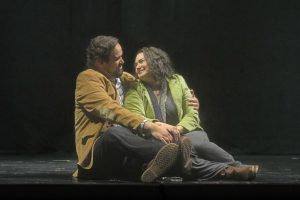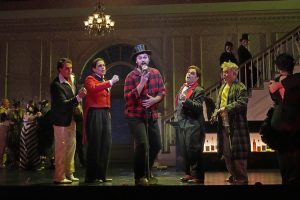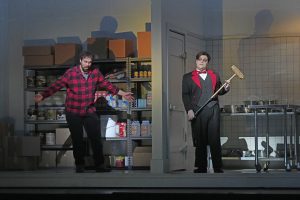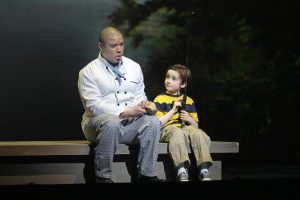One of the reasons that Stephen King’s horror stories are so indelibly etched onto our consciousness is that their macabre ingenuity has lent itself so readily to screen adaptation. Far more people know Misery or The Green Mile or Children of the Corn from the film versions than from their literary originals. Yet for all the movies that these novels have spawned, adaptations for the stage are rare, and those for the musical stage, rarer still. Carrie was made into a Broadway musical in 1988, which despite a disastrous initial run was revived off-Broadway in 2012. Composer Tobias Picker adapted Dolores Claiborne for San Francisco Opera in 2013, with considerably more success.
Still, Broadway musicals aside, the question remains open as to whether the macabre nature of King’s novels could spark a trend toward “horror opera” in the vein of Britten’s Turn of the Screw or Debussy’s unfinished The Fall of the House of Usher (not to mention the spate of recent operatic versions of such standards as Frankenstein and Dracula).

Edward Parks and Kelly Kaduce / All photos by Ken Howard
Since its premiere at Minnesota Opera in 2016, The Shining, with music by Paul Moravec and a libretto by Mark Campbell, has made perhaps the strongest case so far for horror opera: It stands out, in fact, as one of the most effective new operas we’ve seen here.
For starters, Mark and his stage director for the project, the insightful Eric Simonson, determined to go back to the 1974 novel and essentially pretend that Stanley Kubrick’s film never existed. Second, they enlisted one of America’s most febrile and brilliantly virtuosic composers, Paul Moravec, to provide the music. And as much as opera is a collaborative effort with many moving parts, it was this music, more than any other element, that gave the Lyric Opera’s local premiere of The Shining its essential vitality.
On March 11th at the Kauffman Center for the Performing Arts, Gerard Schwarz, one of the world’s most eminent conductors, led the Kansas City Symphony in a blisteringly vivid rendering of the Pulitzer Prize-winning composer’s score: reminding us of the extent to which many of the best operas thrive on magnificent music in the service of storytelling.

Trent Green, Roger Honeywell, Edward Parks, Wayd Odle, and Malcolm MacKenzie
This is not to downplay the other elements of the performance, which included the original director and scenic, costume and projection and lighting designers: all imported “of a piece” from the Minnesota production. Moreover, the performance was being recorded live for international issue next year.
If there is a reason for making an opera out of any story, it is because music permits a literary or stage work to explore ineffable psychological depths in ways that language alone cannot. Paul Moravec has employed extensive orchestral and choral forces, splashed throughout with kaleidoscopic colors, toward making this into an eerie musical saga of enormously sophisticated detail.
When wide-eyed Danny (the startlingly effective Tristan Hallett) serves as a conduit for the Overlook’s ghostly messages of doom, his words are accompanied by haunting vocal tone-clusters sung by an unseen choir. Later, the snowstorm that threatens to strand the family is expressed by a groaning male chorus. When the ballroom ghosts dance, the music is only superficially upbeat: Undercurrents of menace help build a sense of unease. The orchestral score alone is rich enough in detail that it will warrant many repeat hearings.

Edward Parks and Wayd Odle
More important, perhaps, is the manner in which music actually breathes life into the characters themselves: largely through arias and ensembles, sung as set-pieces throughout.
“Stop and sing” moments are, after all, primary elements that separate an opera from a stage play. The Shining opens, in fact, with a duet between Jack (Edward Parks) and Wendy (Kelly Kaduce). “I did the right thing, Wendy, for once in my life,” Jack sings, in a sympathetic scene that helps establish a loving bond that is about to be threatened through otherworldly forces. A subsequent ensemble of Jack, Dick Halloran (Aubrey Allicock), Wendy, and Hotel Manager Stuart Ullman (Roger Honeywell) is an attempt to reassure the nervous newcomers that “All will be fine… don’t you fret.” Later in this act, Wendy sings a warmly personal aria (“I never stopped loving you”), which on Saturday drew applause: a phenomenon that is relatively rare for contemporary opera.
Edward sang with warmth and color throughout, though his voice didn’t always project over the busy orchestra. Kelly conveyed a maternal warmth, the sense of hysteria increasing through the evening as her vocal production intensified. Wayd’s fierce tenor lashed out with unctuous dread, Powell Brumm was a harrowing Horace Derwent, and Malcolm MacKenzie sang Jack’s father with gruff force.

Aubrey Allicock and Tristan Hallett
The largest share of vocal kudos go to Aubrey Allicock, whose baritone is so plush and inviting that you want to rest in it. Dick Halloran provides a rare glimmer of hope in the midst of all this horrendous upheaval. He also has two of the finest musical moments of the opera: the Act I “Shine on” aria and the gorgeous “These woeful days will be over” (sung to Danny, but also to us). As dissonance clears to make way for lush tonality, Dick closes the opera with a moving and beautifully crafted aria.
The Shining is a complex, many-layered story, and compressing it into two concise acts is a challenge: The latter scenes of Act I bogged down, as Jack began to lose touch with reality and the ballroom ghosts came out to sing and dance. It felt as if we were getting too much language, too much information, too much trauma to deal with in just a half an hour’s time. In contrast, the entirety of Act II felt straightforward and well paced, in spite of (or perhaps because of) its explosive emotional content.
The other stars of this production are the meticulously crafted set designs by Erhard Rom (with its neatly interchangeable study, bedroom, and kitchen, and its vast ballroom) and the intricate projections (by 59 Productions and Brian Pacelli) that mimicked everything from pallid hotel windows to walls of blood. The lighting by Robert Wierzel helped create, among other things, the eerie paleness of Danny’s “spells,” and costumes by Kärin Kopischke continually grounded us in the proper time period: from Roaring Twenties to absurdly wide 1970s shirt-lapels.
—By Paul Horsley
The Shining continues through March 19th. For tickets, call 816-471-7344 or go to kcopera.org.
To reach Paul Horsley, performing arts editor, send an email to paul@kcindependent.com or find him on Facebook (paul.horsley.501) or Twitter/Instagram (@phorsleycritic).